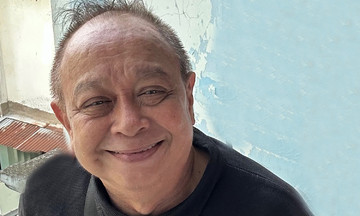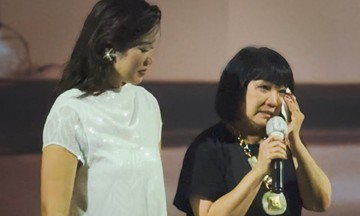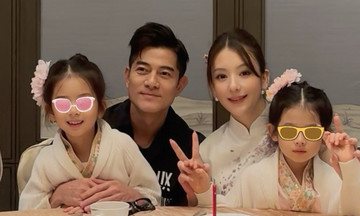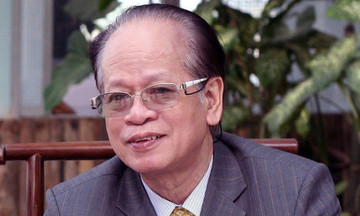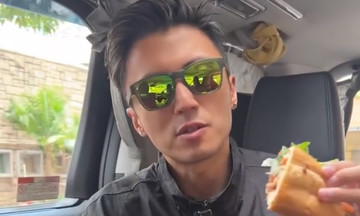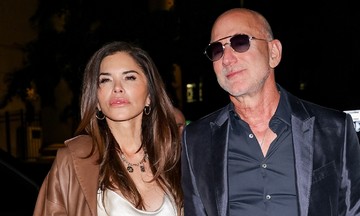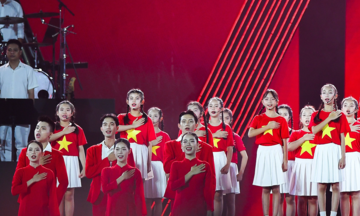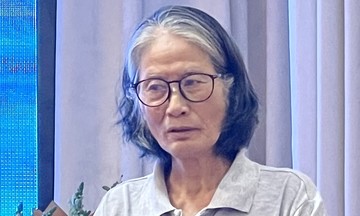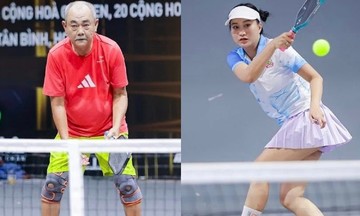For 80 years, the composition has become "the song of the people", as Van Cao himself put it. Children learn the anthem by heart from their first days in school. The song opens all important ceremonies and national events, embodying solemnity and national pride.
50,000 people sing "Tien Quan Ca" at the "national concert" "To Quoc Trong Tim" on 10/8 at My Dinh National Stadium. Video: Provided by the organizers
On 10/8, at the "To Quoc Trong Tim" concert, the sight of over 50,000 people singing "Tien Quan Ca" together moved the audience. During Van Cao's 100th birthday celebration in 8/2023, thousands of artists and audience members sang the song at the August Revolution Square. The performance recreated the moment when the national anthem ("Tien Quan Ca") debuted at a rally in Hanoi supporting the Viet Minh on 19/8/1945. In recent years, various arrangements of the song have emerged, all retaining its powerful and heroic resonance.
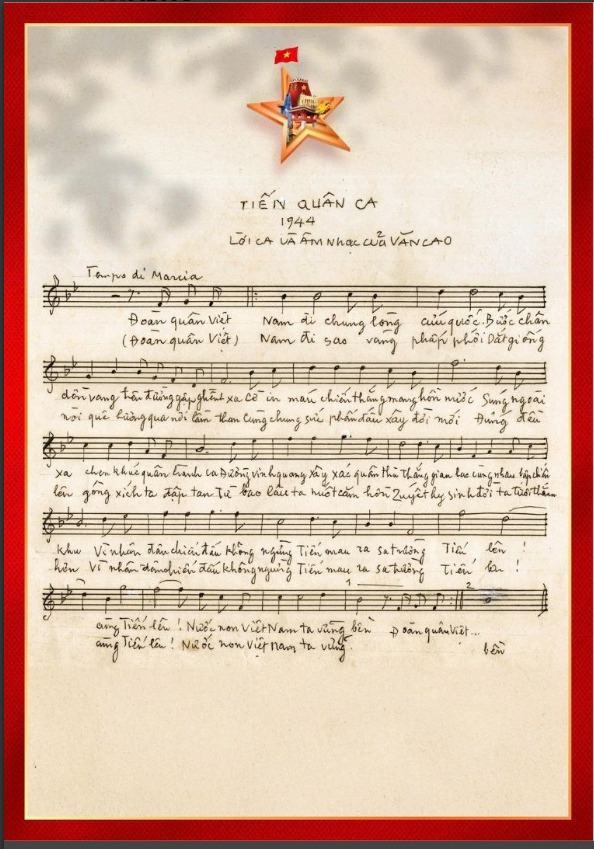 |
Van Cao's handwritten manuscript of "Tien Quan Ca", printed on the "To Quoc Trong Tim" concert ticket. Image: Provided by the organizers |
Van Cao's handwritten manuscript of "Tien Quan Ca", printed on the "To Quoc Trong Tim" concert ticket. Image: Provided by the organizers
The song was born in the winter of 1944, when Van Cao was auditing classes at the Indochina Fine Arts College, making a living by selling paintings, writing poetry, and stories. He stayed at a friend's house in Hanoi. At that time, Hanoi was suffering from famine, so Van Cao couldn't sell his paintings. He relied on fellow artists for food and support.
Vu Quy, a Viet Minh cadre, persuaded him to join the revolution. While Van Cao was eager to take up arms, Vu Quy assigned him a cultural task: to compose a march to inspire the resistance forces.
In his memoir "Why I Wrote Tien Quan Ca", the musician recounted the afternoon after receiving the assignment, wandering the streets until the streetlights came on. Seeing starving people, including a child wandering aimlessly by the roadside, he remembered his three-year-old nephew who had gotten lost and burst into tears. That night, he wrote the first notes of "Tien Quan Ca".
Tung Duong and 30,000 spectators sing "Tien Quan Ca" at the "Proud to be Vietnamese" program on 17/8 in Hanoi. Video: Provided by the organizers
He wrote the song in a small attic room at 45 Nguyen Thuong Hien Street, by a window overlooking a two-story house. There, he often heard the sound of ox carts carrying the bodies of famine victims to Kham Thien.
"I had not yet held a gun, nor joined any armed forces. I was only writing a song. I hadn't been to the war zone, only knew the streets of Ga, Hang Bong, and Bo Ho, where I habitually walked. I hadn't met our revolutionary soldiers in that first military training course. And I knew how they were singing. Here, I was thinking of how to write a simple song for them to sing," the musician wrote.
He wrote and revised the song for many days, during the bleak winter days, with the opening lines:
"The Vietnamese army marches
United in saving the nation
Footsteps resounding on the long, arduous road"
In the second verse, he envisioned the golden star on the red flag fluttering amidst the green mountains and forests:
"The Vietnamese army marches
Golden star fluttering
Leading the nation through hardship"
He wanted the song not just for the students in the anti-Japanese military training course, or the soldiers fighting, but for the entire nation, hence the line "Forward! Together forward". Upon completion, he gave it to Vu Quy. That afternoon, he also took charge of the Phan Chu Trinh secret printing house, laying out the Doc Lap newspaper and printing materials for the Viet Minh. Poet Nguyen Dinh Thi handled the newspaper's content. Because the typesetter couldn't transcribe musical notation, Van Cao had to go to the secret printing house in Bat Trang village to personally write and print "Tien Quan Ca" in the first issue of Doc Lap. The song was then sent to all battlefronts.
In 8/1945, the Party Central Committee and President Ho Chi Minh convened the National Congress at Tan Trao. Nguyen Dinh Thi presented three songs: "Diet Phat Xit" (Destroy Fascism), which he composed, along with "Chien Si Viet Minh" (Viet Minh Soldier) and Van Cao's "Tien Quan Ca". President Ho Chi Minh chose "Tien Quan Ca" as the national anthem.
On 19/8/1945, before the people of Hanoi took over the Bac Bo government, Van Cao conducted the Youth Pioneer Choir in performing the song at August Revolution Square.
On 2/9/1945, at Ba Dinh Square, tens of thousands sang the song and listened to President Ho Chi Minh read the Declaration of Independence, giving birth to the Democratic Republic of Vietnam.
Van Cao wrote in his memoirs: "When I heard the voices of tens of thousands singing, I was deeply moved, and tears welled up. And I understood that the national anthem, now 'Tien Quan Ca', no longer belonged to me. 'Tien Quan Ca' belonged to the people."
On 2/3/1946, the National Assembly held its first plenary session at the Hanoi Opera House, electing a new government headed by Ho Chi Minh. During the session discussing the national anthem, some delegates proposed Hung Lan's "Viet Nam Minh Chau Troi Dong" as a replacement. Nguyen Dinh Thi immediately stood up and began singing "Tien Quan Ca", and the entire hall joined in. No one mentioned changing the anthem again.
In 1981, a campaign to compose a replacement national anthem was launched, but the National Assembly ultimately decided to retain "Tien Quan Ca". For 80 years, the piece has been intertwined with the nation's history, creating lasting memories for generations of Vietnamese.
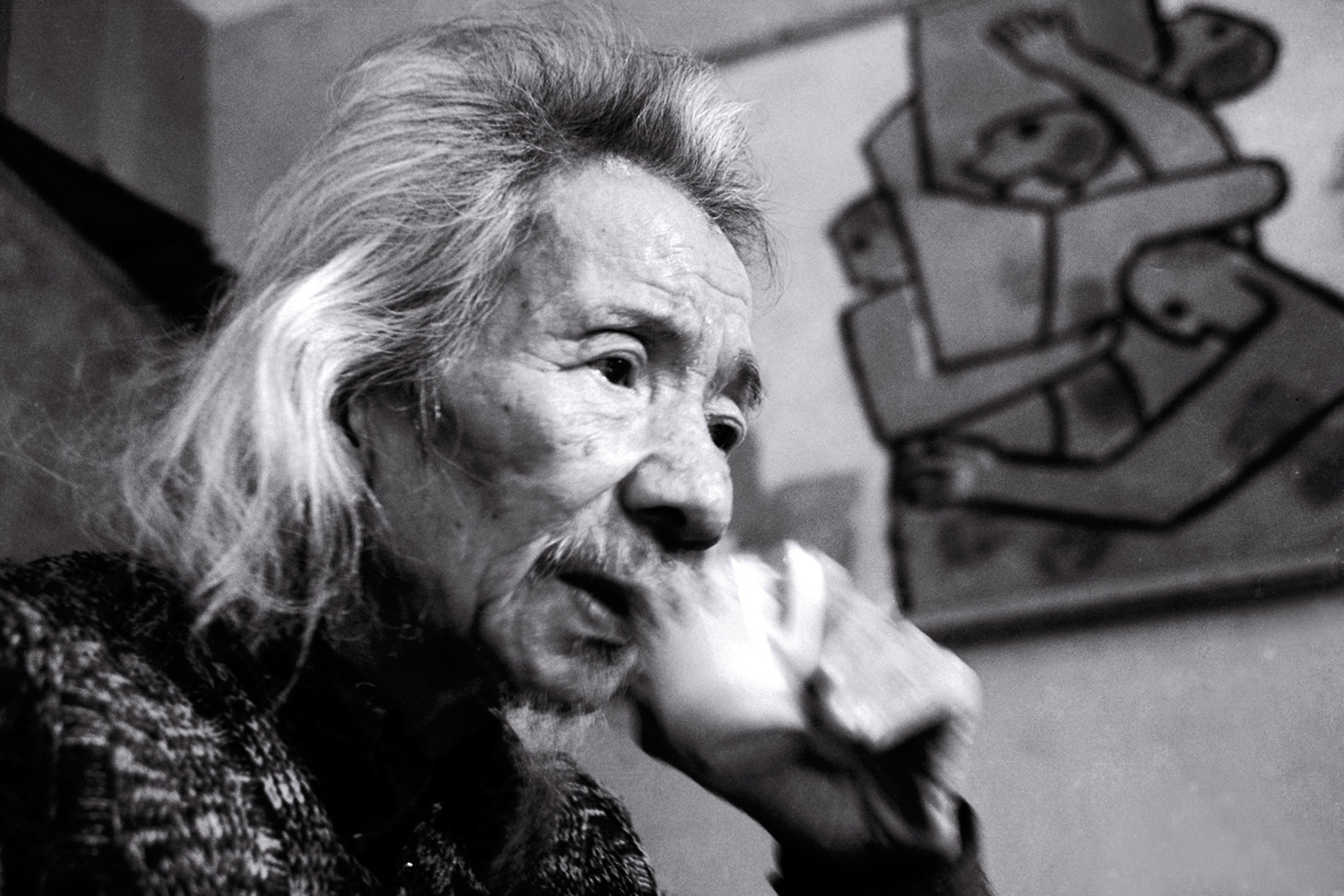 |
Musician Van Cao. Photo: Photographer Nguyen Dinh Toan |
Musician Van Cao. Photo: Photographer Nguyen Dinh Toan
Musician An Hieu, son of musician An Thuyen, believes the song has become a symbol of the nation's vitality and the character of the Vietnamese people. "The lyrics are simple yet profound, affirming the spirit of patriotism. The melody is memorable, easy to learn, and familiar to the masses. The song's structure is solid. I always feel moved when I hear this song," he said.
According to the musician's will, in 2016, Van Cao's wife and children donated "Tien Quan Ca" to the State.
Van Cao was born on 15/11/1923 in Hai Phong and passed away on 10/7/1995. He was an influential artist in Vietnamese modern music, considered a genius in the history of Vietnamese arts and culture. Without formal musical training, he displayed his talent before turning 20, with romantic lyrical songs like "Ben Xuan" (Spring Wharf), "Suoi Mo" (Dream Stream), "Thien Thai" (Heaven), and "Truong Chi".
After joining the revolution at 21, he composed many heroic songs such as "Tien Quan Ca", "Truong Ca Song Lo" (Song Lo Epic), "Tien Ve Ha Noi" (Advancing to Hanoi), and "Lang Toi" (My Village). Besides music, he also wrote poetry, painted, and worked as a journalist. Van Cao was posthumously awarded the Ho Chi Minh Prize for Literature and Arts in 1996.
Ha Thu




